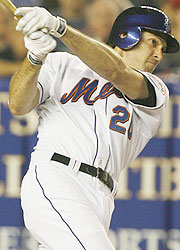
A Power Hitter. And a Source of Jewish Pride.
Not that there’s any pressure on Shawn Green to succeed in New York, but when Mr. Green — power-hitting right fielder, two-time All-Star, Jew — took the field in a Mets uniform for the first time on Thursday, a fan named Corey Mintz held up a poster with Mr. Green’s photo on it.
“The messiah has arrived,” the poster read.
Jews are famed for their prowess in many fields, but have long been stereotyped, even by themselves, as being weak in athletics. There might not be a group on the planet with a more finely honed sense of physical inferiority.
So when a star ballplayer who happens to be Jewish comes to play in the New York area, a capital of Jewish culture, home to nearly two million Jews, it is cause for much rejoicing.
Americans, Jewish and otherwise, may not hold sports stars in the esteem they once did. Jews no longer feel quite the need to prove themselves as Americans by, for instance, excelling at sports.
But still the Jewish people hunger for a hometown hero to call their own.
When David Cone came to the Mets in 1987, he was inundated with bar mitzvah invitations, said Jay Horwitz, the Mets’ longtime public relations man. A reporter from
The same thing happened last year when the Mets brought up a first baseman named Michael Jacobs. “Every question I got was ‘Is Mike Jacobs Jewish? Is Mike Jacobs Jewish?’ ” Mr. Horwitz said. He is not.
Mr. Green, acquired from the Arizona Diamondbacks this week to give the Mets an offensive lift as they look toward the playoffs, is the real deal. He is arguably the best Jewish baseball player since Koufax. He may be the most accomplished Jew to wear a
And his people are clamoring to embrace him. “I must have gotten 20 calls yesterday and today,” said Alan Freedman, the director of the National Jewish Sports Hall of Fame and Museum in
On the streets of
“He’s a team player, and he’s on our team, if you know what I’m saying,” Mr. Moskowitz said.
And in the stands at Shea Stadium, Joshua Ostrovsky, a husky Manhattanite with a billowing Jewish afro and a gold Hebrew “chai” necklace outside his Dwight Gooden jersey, called Mr. Green a role model.
“There were many times in Little League that people said to me, ‘Ostrovsky, you are fat, you’re Jewish, you’ll never play baseball.’ ” said Mr. Ostrovsky, 24. “So I lost weight, and they still said, ‘You’ll never play baseball because you are Jewish.’ Shawn has been an inspiration to me.”
The history of Jewish major league baseball players in
“Have you ever heard of the Rabbi of Swat?” asked Martin Abramowitz, president of Jewish Major Leaguers, a nonprofit group. There really was one. His name was Mose Solomon, and he played in two games for the New York Giants in 1923 before switching to football.
In the 20’s and 30’s, Mr. Abramowitz said, both the Giants and the Dodgers actively recruited Jewish players in hopes of drawing the city’s growing Jewish population to the ballpark. In 1941, the Giants fielded four Jews in the same game.
The Giants had a star in Mr. Danning, who hit .300 three years in a row. But most Jewish ballplayers on
“There was a lot of pride even when they didn’t do particularly well,” said Matthew Maryles, the president of the Jewish Community Relations Council of New York. Mr. Maryles, scheduled to throw out the first ball at Jewish Heritage Day at Shea Stadium tomorrow, said his childhood hero was Cal Abrams of the Dodgers, perhaps best known for ending his team’s 1950 pennant run by getting thrown out at home plate.
“Jews at that time weren’t totally sure of themselves in American society like they are today,” Mr. Maryles said. “Baseball was a way of proving we were part of
The best Jewish players from
Koufax started his career with the Dodgers in his home borough of Brooklyn but did not come into his own until the team moved to
In the modern era, the Miracle Mets of 1969 had Art Shamsky. In the 70’s, the Yankees had Ron Blomberg, a promising slugger who was hobbled by injuries for most of his career but still achieved enormous popularity. “I had people every single game to bring me bagels,” said Mr. Blomberg, who recently published a book “Designated Hebrew,” about his playing days.
Which brings up Mr. Green, a strapping six-footer with a dimpled chin, born near Chicago 34 years ago and raised near Los Angeles without so much as a bar mitzvah. In
Mr. Green’s best years are generally agreed to be behind him — he has not driven in more than 100 runs since 2002 — but Mr. Abramowitz said he had high hopes for him.
“By the end of the season, he’s probably going to be the only Jewish player in the history of the game with 300 home runs, 1,000 RBI’s and close to 1,900 hits,” he said.
Though Mr. Green arrives just in time for Jewish Heritage Day, which was scheduled long in advance, Mr. Horwitz promised that his acquisition was not a marketing stunt — not when he comes with a contract paying about $10 million a year. “This was a baseball decision,” he said.
Mr. Green, for his part, seems happy to be in
So far, so good. In his second at-bat Thursday, he lined a run-scoring single to left field and the place erupted.
“Ma-zel tov! Ma-zel tov!” Mr. Ostrovsky chanted to the rhythm of “Let’s Go Mets.”
Mr. Ostrovsky pulled at his mane of kinky hair.
“I haven’t been this proud of a Jew since my brother’s bar mitzvah,” he said.